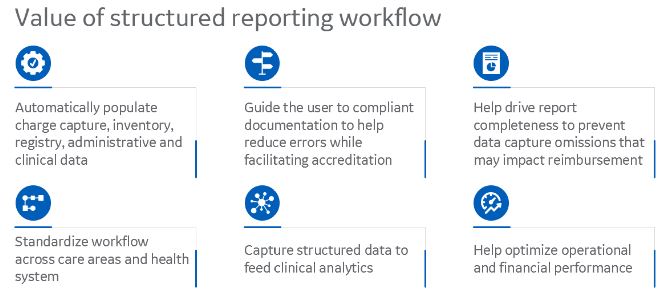Considering the impact structured reporting could have for your Cardiovascular department? DAIC recently covered ‘Why Structured Reporting is Needed in Cardiology’.
The cardiovascular care area spans a diverse mix of device and systems to help diagnose and care for your patients. Structured reporting incorporates best practice workflows for data capture and documentation that can provide multiple benefits—as shown below, and discussed in this article.
Based on challenges in cardiology reporting today, we’ve compiled the below guide of three capabilities to look for in a Cardiovascular IT solution that supports structured reporting.
1. User-Centric Design
It may sound obvious, but at the most basic level, your structured reporting solution must be easy to navigate and provide flexible workflow. The solution should be intuitive for physicians to learn and deliver clinically deep reports that are relevant compared to current care standards.
A strong solution provides you with features to help quickly document typical results. One feature to consider is quick reports, which allows the user to complete multiple fields across multiple forms with the click of a button.
Ideally, the user interface displays the form and report side by side, so that you can visualize your report building as you interact with form data, which allows you to adjust quickly. Side-by-side reporting combined with quick reports can help you complete each report in fewer clicks.
As a bonus, visual indicators can be used to draw your attention to missing required fields which helps administrators ensure physicians are completing the necessary documentation in accordance with industry standards but also ensuring reports are complete to maximize reimbursement.
2. Clinical and IT Integration
You also need a structured reporting solution that can bring your data and images together across cardiology care pathways. By consolidating departmental silos, you’ll get a single point of access to procedural data, reports, measurements, waveforms, images, advanced analysis and workflow tools.
Consider the costs of repetitive manual work. Structured reporting workflow can help reduce duplicate data entry, for example, by automating the import of measurements into the report which can populate exam findings, saving time and potential errors.
Good structured reporting tools also leverage robust modules with interfaces to complement your EHR/HIS with procedural data—meanwhile, helping to streamline data capture and administrative tasks. This is the modular architecture that becomes your single (and scalable) point of access.
3. Analytics
It might be a buzzword, but powerful analytics are fast becoming a top priority for healthcare providers today. Clinical and business analytics can help you identify areas for improvement to optimize clinical, operational and financial performance.
Especially in interventional cardiology where material cost and waste can be quite high. Monitoring inventory to limit waste and standardize usage can have a big financial impact. The ability to extract and analyze data from your structured reporting solution can help your organization take a step closer to realizing these benefits.
The Solution
These capabilities come together to help streamline physician reporting, enable workflow standardization and help optimize clinical care, operational and financial outcomes.
CentricityTM Cardio Enterprise*, an enterprise cardiovascular IT solution consisting of structured reporting, workflow, image analysis and analytic tools, helps cardiology team’s complete physician reports with fewer clicks and in less time. See what one customer was able to achieve.
It’s important that physicians and other stakeholders are involved in the selection process and that your vendor has the clinical, technical and leadership expertise to implement and support your team.
To learn about GE Healthcare’s Cardiovascular IT solution, visit our website.
*Centricity Cardio Enterprise is a solution comprised of Centricity Universal Viewer and Centricity Cardio Workflow.


